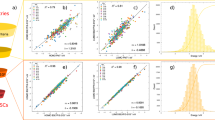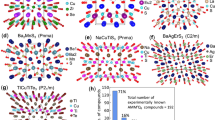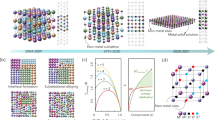Abstract
Chemists and material scientists have often focused on the properties of previously reported compounds, but neglect numerous unreported but chemically plausible compounds that could have interesting properties. For example, the 18-valence electron ABX family of compounds features examples of topological insulators, thermoelectrics and piezoelectrics, but only 83 out of 483 of these possible compounds have been made. Using first-principles thermodynamics we examined the theoretical stability of the 400 unreported members and predict that 54 should be stable. Of those previously unreported ‘missing’ materials now predicted to be stable, 15 were grown in this study; X-ray studies agreed with the predicted crystal structure in all 15 cases. Among the predicted and characterized properties of the missing compounds are potential transparent conductors, thermoelectric materials and topological semimetals. This integrated process—prediction of functionality in unreported compounds followed by laboratory synthesis and characterization—could be a route to the systematic discovery of hitherto missing, realizable functional materials.
This is a preview of subscription content, access via your institution
Access options
Subscribe to this journal
Receive 12 print issues and online access
$259.00 per year
only $21.58 per issue
Buy this article
- Purchase on Springer Link
- Instant access to full article PDF
Prices may be subject to local taxes which are calculated during checkout




 ).
).
Similar content being viewed by others
References
FIZ Karlsruhe. Inorganic Crystal Structure Database (Karlsruhe, 2006).
Kabekkodu, S. Powder Diffraction File (International Centre for Diffraction Data, 1997).
Villars, P. & Calvert, L. D. Pearson's Handbook of Crystallographic Data for Intermetallic Phases (ASM International, 1991).
Bloch, J. et al. Prediction and hydrogen acceleration of ordering in iron–vanadium alloys. Phys. Rev. Lett. 108, 215503 (2012).
Feng, J., Hennig, R. G., Ashcroft, N. W. & Hoffmann, R. Emergent reduction of electronic state dimensionality in dense ordered Li–Be alloys. Nature 451, 445–448 (2008).
Lu, Z. W., Wei, S-H., Zunger, A., Frota-Pessoa, S. & Ferreira, L. G. First-principles statistical mechanics of structural stability of intermetallic compounds. Phys. Rev. B 44, 512–544 (1991).
Pickard, C. J. & Needs, R. J. Structure of phase III of solid hydrogen. Nature Phys. 3, 473–476 (2007).
Ceder, G. Opportunities and challenges for first-principles materials design and applications to Li battery materials. Mater. Res. Soc. Bull. 35, 693–701 (2010).
Greeley, J., Jaramillo, T. F., Bonde, J., Chorkendorff, I. & Nørskov, J. K. Computational high-throughput screening of electrocatalytic materials for hydrogen evolution. Nature Mater. 5, 909–913 (2006).
Hautier, G. et al. Phosphates as lithium-ion battery cathodes: an evaluation based on high-throughput ab initio calculations. Chem. Mater. 23, 3495–3508 (2011).
Katsnelson, M. I., Irkhin, V. Y., Chioncel, L., Lichtenstein, A. I. & de Groot, R. A. Half-metallic ferromagnets: from band structure to many-body effects. Rev. Mod. Phys. 80, 315–378 (2008).
Nielsen, M. D., Ozolins, V. & Heremans, J. P. Lone pair electrons minimize lattice thermal conductivity. Energy Environ. Sci. 6, 570–578 (2013).
Wang, S., Wang, Z., Setyawan, W., Mingo, N. & Curtarolo, S. Assessing the thermoelectric properties of sintered compounds via high-throughput ab-initio calculations. Phys. Rev. X 1, 021012 (2011).
Yang, K., Setyawan, W., Wang, S., Nardelli, M. B. & Curtarolo, S. A search model for topological insulators with high-throughput robustness descriptors. Nature Mater. 11, 614–619 (2012).
Yu, L. & Zunger, A. Identification of potential photovoltaic absorbers based on first-principles spectroscopic screening of materials. Phys. Rev. Lett. 108, 068701 (2012).
Curtarolo, S. et al. The high-throughput highway to computational materials design. Nature Mater. 12, 191–201 (2013).
Butler, W. H., Zhang, X-G., Schulthess, T. C. & MacLaren, J. M. Spin-dependent tunneling conductance of Fe|MgO|Fe sandwiches. Phys. Rev. B 63, 054416 (2001).
Chen, H. et al. Carbonophosphates: a new family of cathode materials for Li-ion batteries identified computationally. Chem. Mater. 24, 2009–2016 (2012).
d'Avezac, M., Luo, J. W., Chanier, T. & Zunger, A. Genetic-algorithm discovery of a direct-gap and optically allowed superstructure from indirect-gap Si and Ge semiconductors. Phys. Rev. Lett. 108, 027401 (2012).
Li, Q. et al. Superhard and superconducting structures of BC5. J. Appl. Phys. 108, 023507 (2010).
Sofo, J. O., Chaudhari, A. S. & Barber, G. D. Graphane: a two-dimensional hydrocarbon. Phys. Rev. B 75, 153401 (2007).
Badzian, A. & Badzian, T. Recent developments in hard materials. Int. J. Refract. Metals Hard Mater. 15, 3–12 (1997).
Gruhn, T. Comparative ab initio study of half-Heusler compounds for optoelectronic applications. Phys. Rev. B 82, 125210 (2010).
Roy, A., Bennett, J. W., Rabe, K. M. & Vanderbilt, D. Half-Heusler semiconductors as piezoelectrics. Phys. Rev. Lett. 109, 037602 (2012).
Sahu, B. R. & Kleinman, L. PtN: a zinc-blende metallic transition-metal compound. Phys. Rev. B 71, 041101 (2005).
Vidal, J., Zhang, X., Yu, L., Luo, J-W. & Zunger, A. False-positive and false-negative assignments of topological insulators in density functional theory and hybrids. Phys. Rev. B 84, 041109 (2011).
Chadov, S. et al. Tunable multifunctional topological insulators in ternary Heusler compounds. Nature Mater. 9, 541–545 (2010).
Lin, H. et al. Half-Heusler ternary compounds as new multifunctional experimental platforms for topological quantum phenomena. Nature Mater. 9, 546–549 (2010).
Xiao, D. et al. Half-Heusler compounds as a new class of three-dimensional topological insulators. Phys. Rev. Lett. 105, 096404 (2010).
Yang, J. et al. Evaluation of half-Heusler compounds as thermoelectric materials based on the calculated electrical transport properties. Adv. Funct. Mater. 18, 2880–2888 (2008).
Abegg, R. Die Valenz und das periodische System. Versuch einer Theorie der Molekularverbindungen. Z. Anorg. Chem. 39, 330–380 (1904).
Hohl, H. et al. New compounds with MgAgAs-type structure: NbIrSn and NbIrSb. J. Phys. A 10, 7843–7850 (1998).
Haase, M. G., Schmidt, T., Richter, C. G., Block, H. & Jeitschko, W. Equiatomic rare earth (Ln) transition metal antimonides LnTSb (T = Rh, Ir) and bismuthides LnTBi (T = Rh, Ni, Pd, Pt). J. Solid State Chem. 168, 18–27 (2002).
Casper, F., Seshadri, R. & Felser, C. Semiconducting half-Heusler and LiGaGe structure type compounds. Phys. Status Solidi A 206, 1090–1095 (2009).
Yan, F. et al. Design of TaIrGe: a ternary half-Heusler transparent hole conductor. Preprint at http://arXiv:1406.0872 (2014).
Mbaye, A. A., Ferreira, L. G. & Zunger, A. First-principles calculation of semiconductor-alloy phase diagrams. Phys. Rev. Lett. 58, 49–52 (1987).
Ferreira, L. G., Wei, S-H. & Zunger, A. First-principles calculation of alloy phase diagrams: the renormalized-interaction approach. Phys. Rev. B 40, 3197–3231 (1989).
Akbarzadeh, A. R., Ozoliņš, V. & Wolverton, C. First-principles determination of multicomponent hydride phase diagrams: application to the Li–Mg–N–H system. Adv. Mater. 19, 3233–3239 (2007).
Zhang, X., Stevanovic, V., d'Avezac, M., Lany, S. & Zunger, A. Prediction of A2BX4 metal–chalcogenide compounds via first-principles thermodynamics. Phys. Rev. B 86, 014109 (2012).
Zhang, X., Yu, L., Zakutayev, A. & Zunger, A. Sorting stable versus unstable hypothetical compounds: the case of multi-functional ABX half-Heusler filled tetrahedral structures. Adv. Funct. Mater. 22, 1425–1435 (2012).
Carrete, J., Li, W., Mingo, N., Wang, S. & Curtarolo, S. Finding unprecedentedly low-thermal-conductivity half-Heusler semiconductors via high-throughput materials modeling. Phys. Rev. X 4, 011019 (2014).
Zakutayev, A. et al. Theoretical prediction and experimental realization of new stable inorganic materials using the inverse design approach. J. Am. Chem. Soc. 135, 10048–10054 (2013).
Heyd, J., Scuseria, G. E. & Ernzerhof, M. Erratum: ‘Hybrid functionals based on a screened Coulomb potential’. J. Chem. Phys. 124, 219906 (2006).
König, M. et al. Quantum spin Hall insulator state in HgTe quantum wells. Science 318, 766–770 (2007).
Sakurada, S. & Shutoh, N. Effect of Ti substitution on the thermoelectric properties of (Zr,Hf)NiSn half-Heusler compounds. Appl. Phys. Lett. 86, 082105 (2005).
Fazzio, A., Caldas, M. J. & Zunger, A. Many-electron multiplet effects in the spectra of 3d impurities in heteropolar semiconductors. Phys. Rev. B 30, 3430–3455 (1984).
Kawazoe, H. et al. p-type electrical conduction in transparent thin films of CuAlO2 . Nature 389, 939–942 (1997).
Kresse, G. & Furthmüller, J. Efficiency of ab-initio total energy calculations for metals and semiconductors using a plane-wave basis set. Comput. Mater. Sci. 6, 15–50 (1996).
Giannozzi, P. et al. QUANTUM ESPRESSO: a modular and open-source software project for quantum simulations of materials. J. Phys. A 21, 395502 (2009).
Kubelka, P. & Munk, F. Ein beitrag zur Optik der Farbanstriche. Z. Tech. Phys. 12, 593–604 (1931).
Tauc, J. Optical properties and electronic structure of amorphous Ge and Si. Mater. Res. Bull. 3, 37–46 (1968).
Hong, B-S., Ford, S. J. & Mason, T. O. Equilibrium electrical property measurements in electroceramics. Key Engineering Mater. 125–126, 163–186 (1996).
McLachlan, D. S., Blaszkiewicz, M. & Newnham, R. E. Electrical resistivity of composites. J. Am. Ceram. Soc. 73, 2187–2203 (1990).
Smits, F. M. Measurement of sheet resistivities with the four-point probe. Bell System Tech. J. 37, 711–718 (1958).
Acknowledgements
This work was performed at Northwestern University and the University of Colorado Boulder with funding provided by the US Department of Energy, Office of Science, Basic Energy Sciences, and Energy Frontier Research Centers, under Contract No. DE- AC36-08GO28308 to the National Renewable Energy Laboratory. We thank G. Trimarchi for helpful discussions.
Author information
Authors and Affiliations
Contributions
X.Z. performed the stability calculations as well as property calculations other than the phonon and dielectric constants carried out by L.Y. R.G., Y.L., L.H., T.O.L.S. and D.C. performed the synthesis and characterization of new ABX materials. The experimental work was supervised by K.R.P. Furthermore, X.Z., R.G. and L.Y. contributed to the writing of the paper. K.R.P. and A.Z. directed the analysis of the results and writing of the paper.
Corresponding authors
Ethics declarations
Competing interests
The authors declare no competing financial interests.
Supplementary information
Supplementary information
Supplementary information (PDF 3257 kb)
Rights and permissions
About this article
Cite this article
Gautier, R., Zhang, X., Hu, L. et al. Prediction and accelerated laboratory discovery of previously unknown 18-electron ABX compounds. Nature Chem 7, 308–316 (2015). https://doi.org/10.1038/nchem.2207
Received:
Accepted:
Published:
Issue Date:
DOI: https://doi.org/10.1038/nchem.2207
This article is cited by
-
Vacancy-mediated anomalous phononic and electronic transport in defective half-Heusler ZrNiBi
Nature Communications (2023)
-
High-throughput calculations of charged point defect properties with semi-local density functional theory—performance benchmarks for materials screening applications
npj Computational Materials (2023)
-
Electronic transport computation in thermoelectric materials: from ab initio scattering rates to nanostructures
Journal of Computational Electronics (2023)
-
First-Principle Calculations to Investigate the Elastic, Thermoelectric, and Electronic Performances of XRhSn (X = V, Nb, Ta) Half-Heusler Compounds
Journal of Superconductivity and Novel Magnetism (2023)
-
Accelerated identification of equilibrium structures of multicomponent inorganic crystals using machine learning potentials
npj Computational Materials (2022)



